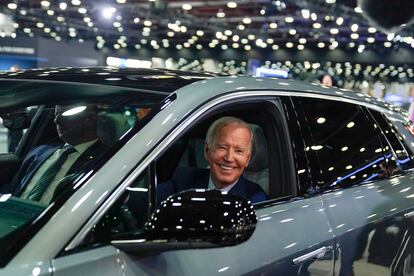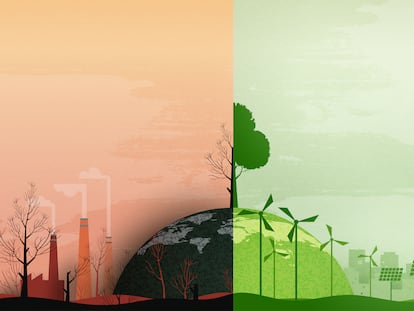EPA issues new auto rules aimed at cutting carbon emissions and boosting electric vehicles and hybrids
The industry could meet the limits if 56% of new vehicle sales are electric by 2032, along with at least 13% plug-in hybrids or other partially electric cars, as well as more efficient gasoline-powered cars

The Biden administration announced new automobile emissions standards Wednesday that officials called the most ambitious plan ever to cut planet-warming emissions from passenger vehicles.
The new rules relax initial tailpipe limits proposed last year but eventually get close to the same strict standards set out by the Environmental Protection Agency.
The rules come as sales of electric vehicles, which are needed to meet the standards, have begun to slow. The auto industry cited lower sales growth in objecting to the EPA’s preferred standards unveiled last April as part of its ambitious plan to cut planet-warming emissions from passenger vehicles.
The EPA said that under its final rule, the industry could meet the limits if 56% of new vehicle sales are electric by 2032, along with at least 13% plug-in hybrids or other partially electric cars, as well as more efficient gasoline-powered cars that get more miles to the gallon.
The new standards will avoid more than 7 billion tons of planet-warming carbon emissions over the next three decades and provide nearly $100 billion in annual net benefits, the EPA said, including lower health care costs, fewer deaths and more than $60 billion in reduced annual costs for fuel, maintenance and repairs.
What is EPA proposing?
The EPA rule applies to model years 2027 to 2032 and will significantly reduce emissions of planet-warming greenhouse gases, as well as other air pollution such as nitrogen oxides and particulate matter from new passenger cars, light trucks and pickups. The rule will help “tackle the climate crisis” and result in widespread reductions in air pollution while accelerating the adoption of cleaner vehicle technologies, the EPA said. The agency is finalizing the rule as sales of clean vehicles, including plug-in hybrid and fully electric vehicles, hit record highs last year.
The new rule slows implementation of stricter pollution standards from 2027 through 2029, after the auto industry called proposed benchmarks unworkable. The rule ramps up to nearly reach the level the EPA preferred by 2032.
“Let me be clear: Our final rule delivers the same, if not more, pollution reduction than we set out in our proposal,’’ EPA Administrator Michael Regan told reporters. In addition to carbon pollution, the final standards also will reduce other serious air pollution that contributes to heart attacks, respiratory illnesses, aggravated asthma and decreased lung function, Regan said.
“Folks, these new standards are so important for public health, for American jobs, for our economy and for our planet,’’ he said.
The standards are designed to be technology-neutral and performance-based, Regan said, giving car and truck manufacturers the flexibility to choose pollution-control technologies that are best suited for their customers while meeting environmental and public health goals.
Why did EPA change the proposed rule?
The changes appear aimed at addressing strong industry opposition to the accelerated ramp-up of EVs, along with public reluctance to fully embrace the new technology. There is also a legitimate threat of legal challenges before conservative courts.
The Supreme Court, with a 6-3 conservative majority, has increasingly reined in the powers of federal agencies, including the EPA, in recent years. The justices have restricted the EPA’s authority to fight air and water pollution — including a landmark 2022 ruling that limited the EPA’s authority to regulate carbon dioxide emissions from power plants that contribute to global warming.
President Joe Biden has made fighting climate change a hallmark of his presidency and is seeking to slash carbon dioxide emissions from gasoline-powered vehicles, which make up the largest single source of U.S. greenhouse gas emissions.
At the same time, the Democratic president needs cooperation from the auto industry and political support from auto workers, a key political voting bloc. The United Auto Workers union, which has endorsed Biden, has said it favors the transition to electric vehicles but wants to make sure jobs are preserved and that the industry pays top wages to workers who build the EVs and batteries.
White House press secretary Karine Jean-Pierre said Tuesday that White House officials “don’t have any concerns” about the final EPA rule. “We know, with these types of things, it takes time,″ she told reporters. “But we’re still going to stay committed to our (climate) goals.”
How are the new rules being received?
Generally, environmental groups have been optimistic about the new EPA plan, which is aimed at slashing emissions from a source that causes one-fifth of the nation’s carbon pollution.
“Over time, these rules will prevent more carbon pollution than the entire U.S. economy coughs up in a year,″ said Manish Bapna, president of the Natural Resources Defense Council. In the short term, the rules “will save drivers money at the pump and cut tailpipe pollution that endangers public health,″ he added.
“In the longer journey to confront the climate crisis, these standards take us in the right direction,″ he said.
“This is a day to celebrate American achievement,″ said Amanda Leland, executive director of the Environmental Defense Fund, another environmental group. The new EPA rule “will slash climate pollution and air pollution .... bring more jobs for workers, more choices and more savings for consumers and a healthier future for our children.″
But Dan Becker at the Center for Biological Diversity, said he fears loopholes will let the industry continue to sell gas burners. He also is afraid the industry will get away with doing little during the first three years of the standards, which could be undone if former President Donald Trump is reelected.
“The bottom line is that the administration is caving to pressure from big oil, big auto and the dealers to stall progress on EVs and now allow more pollution from cars,” Becker said.
What do Trump and other Republicans say?
At a Detroit-area rally in September, Trump insisted Biden’s embrace of electric vehicles — a key component of his clean-energy agenda — would ultimately lead to lost jobs.
“He’s selling you out to China, he’s selling you out to the environmental extremists and the radical left,” Trump told his crowd, flanked by American flags and pallets of auto parts.
Republicans and some in the industry have called the rule an EV mandate, but Regan and White House officials pushed back on that.
“You know, maybe some would like for it to be an EV mandate, but that clearly is not the case, when you look at the multiple pathways companies can choose to comply″ with the rule, Regan said. “We are staying well within the confines of the law and our statutory authority by not mandating a specific technology.″
The EPA could achieve its carbon pollution goals even if sales of battery electric vehicles are as low as 30% in 2032, as long as other standards are met, he said.
U.S. electric vehicle sales grew 47% last year to a record 1.19 million as EV market share rose from 5.8% in 2022 to 7.6%. But EV sales growth slowed toward the end of the year. In December, they rose 34%.
What does the car industry think?
The Alliance for Auto Innovation, a large industry trade group, praised the EPA’s slower implementation of the standards, saying the pace of the EV transition matters as the industry moves to produce more electric vehicles and plug-in hybrids to convert more traveling miles to electricity. The group had complained that the ramp-up to 67% initially proposed by the EPA was too fast for the industry to achieve. The proposal was faster than Biden’s goal of ensuring that EVs account for half of new vehicles in the U.S. by 2030.
“Moderating the pace of EV adoption (from 2027 through 2030) was the right call because it prioritizes more reasonable electrification targets in the next few, very critical years of the transition,” said John Bozzella, the Alliance CEO.
The adjusted emissions targets will still be a stretch for the industry to achieve, Bozzella said, but they should give the market and parts supply chains a chance to catch up to higher EV sales. The plan also gives the industry more time to set up public charging stations, and it allows government tax incentives for EV manufacturing and for consumers to buy EVs to take hold, he said.
Toyota, the top seller of hybrid vehicles in the U.S., said it believes the fastest way to reduce carbon emissions quickly is to give consumers choices of battery electric vehicles and hybrids. The new EPA standards allow for more sales of plug-in hybrids and regular gas-electric hybrids to meet emissions limits.
Sign up for our weekly newsletter to get more English-language news coverage from EL PAÍS USA Edition
Tu suscripción se está usando en otro dispositivo
¿Quieres añadir otro usuario a tu suscripción?
Si continúas leyendo en este dispositivo, no se podrá leer en el otro.
FlechaTu suscripción se está usando en otro dispositivo y solo puedes acceder a EL PAÍS desde un dispositivo a la vez.
Si quieres compartir tu cuenta, cambia tu suscripción a la modalidad Premium, así podrás añadir otro usuario. Cada uno accederá con su propia cuenta de email, lo que os permitirá personalizar vuestra experiencia en EL PAÍS.
¿Tienes una suscripción de empresa? Accede aquí para contratar más cuentas.
En el caso de no saber quién está usando tu cuenta, te recomendamos cambiar tu contraseña aquí.
Si decides continuar compartiendo tu cuenta, este mensaje se mostrará en tu dispositivo y en el de la otra persona que está usando tu cuenta de forma indefinida, afectando a tu experiencia de lectura. Puedes consultar aquí los términos y condiciones de la suscripción digital.
More information
Archived In
Últimas noticias
The complicated life of Francesca Albanese: A rising figure in Italy but barred from every bank by Trump’s sanctions
From digital curfews to blocking apps: How technology experts protect their children online
Why the price of coffee has skyrocketed: from Brazilian plantations to specialty coffee houses
Confined to a Cuban hospital: When electricity is a matter of life or death
Most viewed
- Pablo Escobar’s hippos: A serious environmental problem, 40 years on
- Why we lost the habit of sleeping in two segments and how that changed our sense of time
- Trump’s obsession with putting his name on everything is unprecedented in the United States
- Charles Dubouloz, mountaineering star, retires at 36 with a farewell tour inspired by Walter Bonatti
- The Florida Keys tourist paradise is besieged by immigration agents: ‘We’ve never seen anything like this’










































